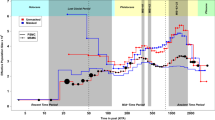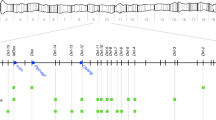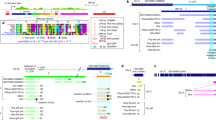Abstract
Selfish DNA, which contains no genetic information but which is perpetuated in eukaryote genomes, has attracted much attention recently1–4. Two classes of selfish DNA have been distinguished: tandemly repetitive sequences such as satellite DNA and dispersed repeated families. Unequal crossing-over is considered to be mainly responsible for spreading of the former, and an integration mechanism (as in bacterial transposons) for evolution of the latter. Here I derive equations and simulate distributions (using randomly generated numbers as data) to show how the numbers of tandem and dispersed repeat units of selfish DNA in a population change with time. I find that whereas the mean number of clustered and dispersed units remains constant, the distribution becomes increasingly dispersed with time.
This is a preview of subscription content, access via your institution
Access options
Subscribe to this journal
Receive 51 print issues and online access
$199.00 per year
only $3.90 per issue
Buy this article
- Purchase on Springer Link
- Instant access to full article PDF
Prices may be subject to local taxes which are calculated during checkout
Similar content being viewed by others
References
Doolittle, W. F. & Sapienza, C. Nature 284, 601–603 (1980).
Orgel, L. E. & Crick, F. H. C. Nature 284, 604–607 (1980).
Cavalier-Smith, T., Dover, G., Smith, T. F. & Reid, R. A. Nature 285, 617–620 (1980).
Orgel, L. E. et al. Nature 288, 645–648 (1980).
Ohta, T. & Kimura, M. Proc. natn. Acad. Sci. U.S.A. 78, 1129–1132 (1981).
Kimura, M. Proc. natn. Acad. Sci. U.S.A. 77, 522–526 (1980).
Calos, M. P. & Miller, J. H. Cell 20, 579–595 (1980).
Young, M. W. Proc. natn. Acad. Sci. U.S.A. 76, 6274–6278 (1979).
Cameron, J. R., Loh, E. Y. & Davis, R. W. Cell 16, 739–751 (1979).
Finnegan, D. J., Rubin, G. M., Young, M. W. & Hogness, D. S. Cold Spring Harb. Symp. quant. Biol. 42, 1053–1063 (1978).
Smith, G. P. Science 191, 528–535 (1976).
Szostak, J. W. & Wu, R. Nature 284, 426–430 (1980).
Petes, T. D. Cell 19, 765–774 (1980).
Reis, R. J. S. & Goldstein, S. Cell 21, 739–749 (1980).
Fry, K. & Salser, W. Cell 12, 1069–1084 (1977).
Hennig, W. & Walker, P. M. B. Nature 225, 915–919 (1970).
Brown, S. D. M. & Dover, G. A. Nature 285, 47–49 (1980).
Author information
Authors and Affiliations
Rights and permissions
About this article
Cite this article
Ohta, T. Population genetics of selfish DNA. Nature 292, 648–649 (1981). https://doi.org/10.1038/292648a0
Received:
Accepted:
Issue Date:
DOI: https://doi.org/10.1038/292648a0
This article is cited by
-
A branching-process model for the evolution of transposable elements incorporating selection
Journal of Mathematical Biology (1991)
-
Transposable element-medicated evolution of sex: A population genetic model
Journal of Genetics (1990)
-
A branching process model for the evolution of transposable elements
Journal of Mathematical Biology (1988)
-
Dynamics of the B-chromosome polymorphism in rye. I. simulated populations
Heredity (1982)
Comments
By submitting a comment you agree to abide by our Terms and Community Guidelines. If you find something abusive or that does not comply with our terms or guidelines please flag it as inappropriate.



